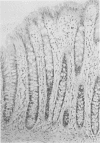Abstract
AIMS--To compare proliferating cell nuclear antigen (PCNA) immunoexpression in hyperplastic polyps, adenomas, and inflammatory cloacogenic polyps of the human colon and rectum using paraffin wax embedded tissue. METHODS--The monoclonal antibody PC10 was used to demonstrate PCNA immunoreactivity in 88 polypoid lesions from 68 patients. Cases in which immunoexpression was completely absent were excluded, leaving 32 hyperplastic polyps, 31 adenomas, and seven inflammatory cloacogenic polyps for analysis. Labelling indices for the upper and lower third of each lesion and for adjacent normal mucosa were calculated. RESULTS--The upper third labelling indices for adenomas were substantially higher than those for hyperplastic polyps or normal mucosa, whereas those for the upper thirds of hyperplastic polyps and normal mucosa did not differ greatly. The differences between the lower third samples were not significant. In 16 (50%) hyperplastic polyps positive cells persisted onto the luminal surface. Some adenomas showed the most intense staining and the highest labelling indices in the upper third, with strong staining of surface cells; this pattern was not seen in the other lesions. The inflammatory cloacogenic polyps did not show a consistent pattern of immunoexpression. CONCLUSIONS--Differences in cell kinetics between adenomas, hyperplastic polyps, and normal mucosa may be shown in formalin fixed, paraffin wax embedded tissue using PC10 as a marker of proliferative activity. PCNA expression also persists into the upper portions of hyperplastic polyps. Assuming that hyperplastic polyps are hypermature lesions with a slower rate of cell migration, this finding suggests that there may be an alteration in PCNA protein metabolism.
Full text
PDF
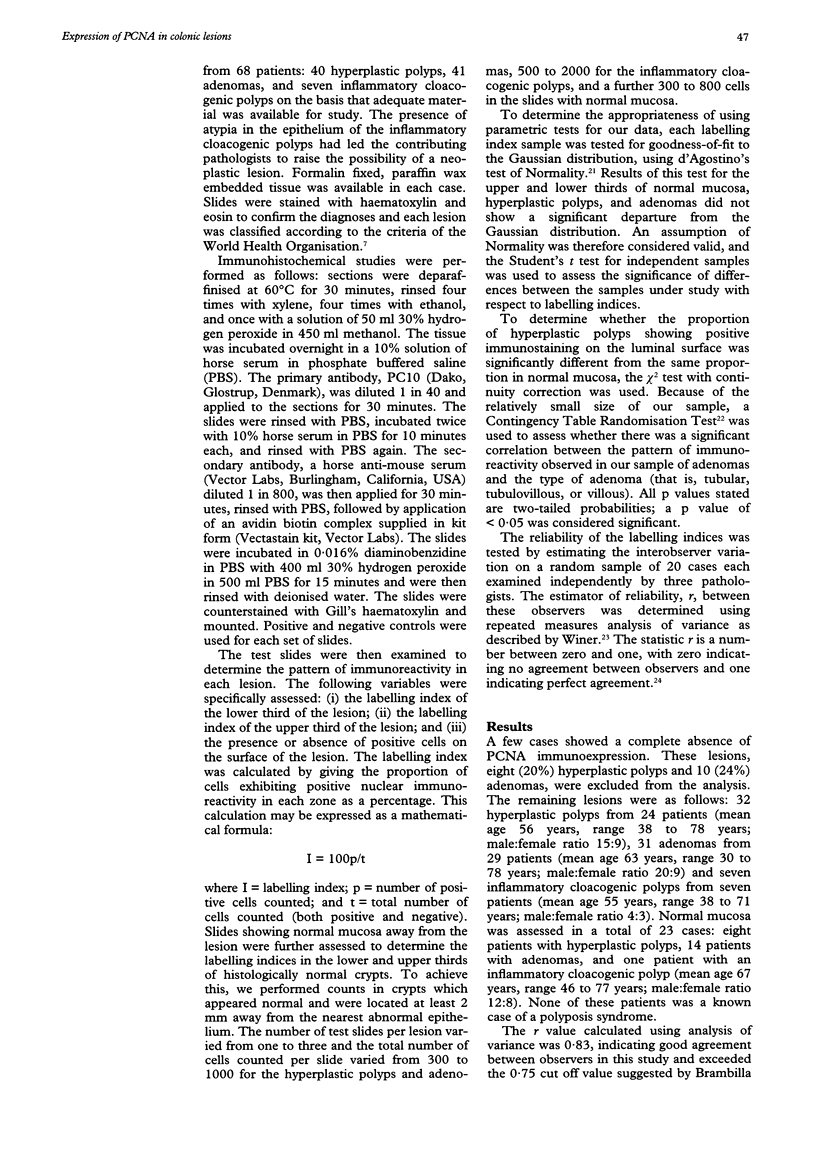
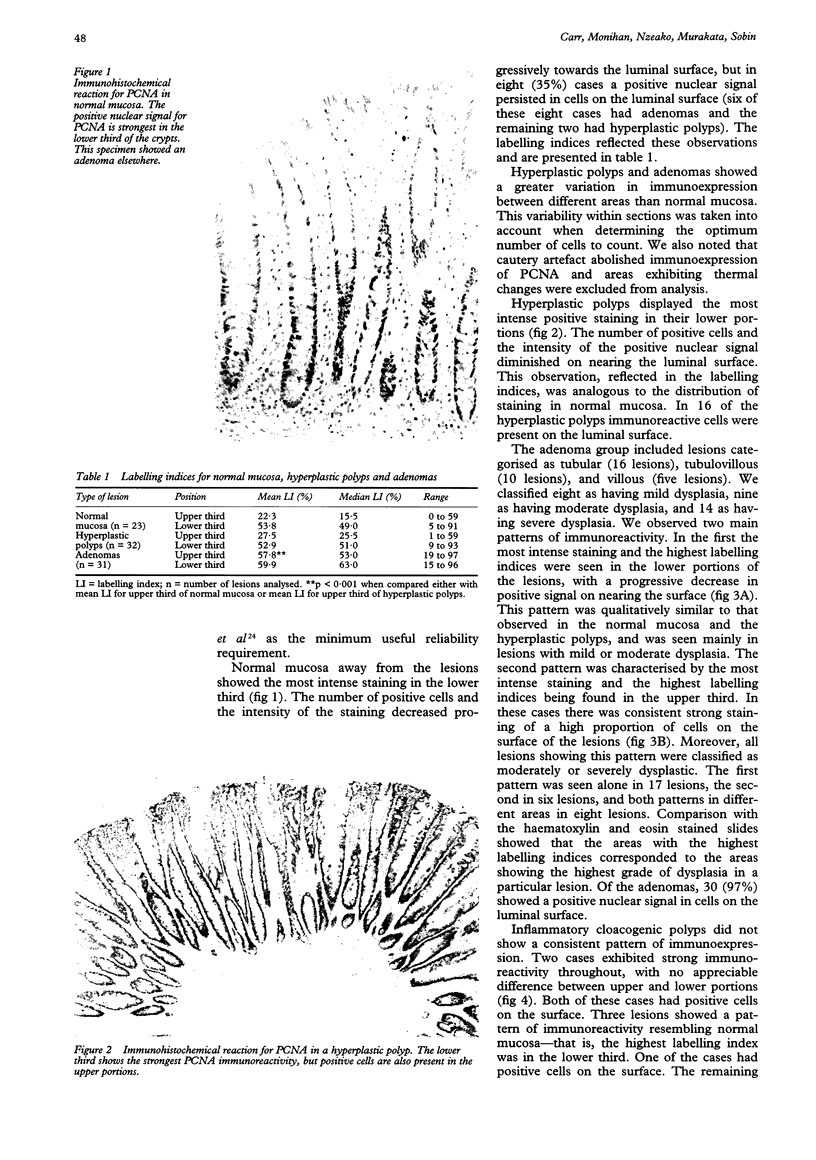
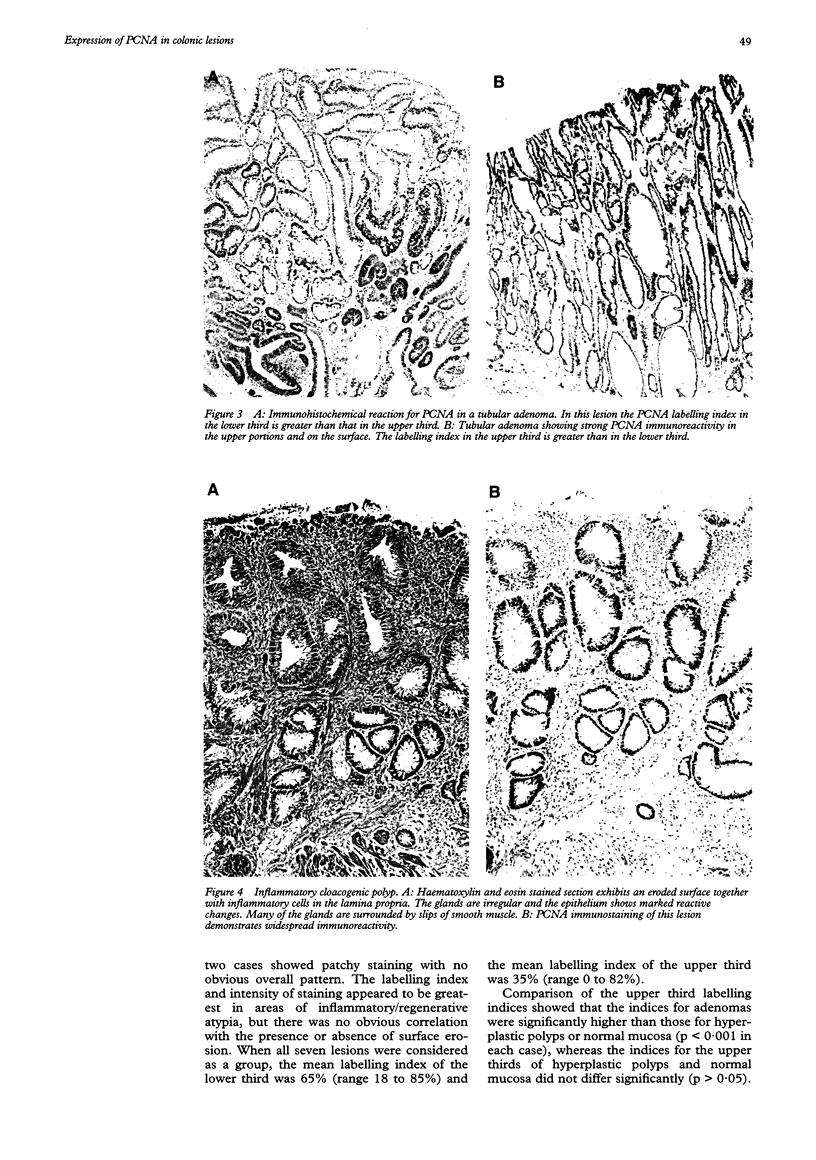
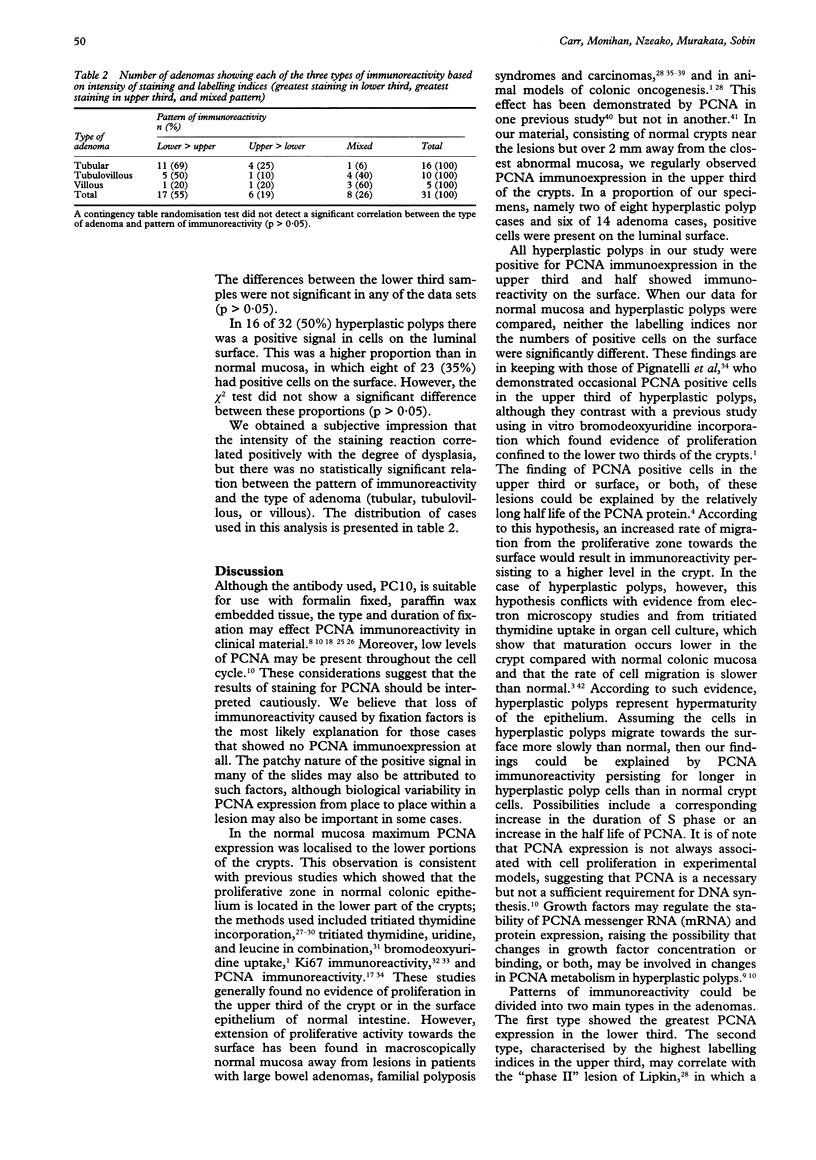
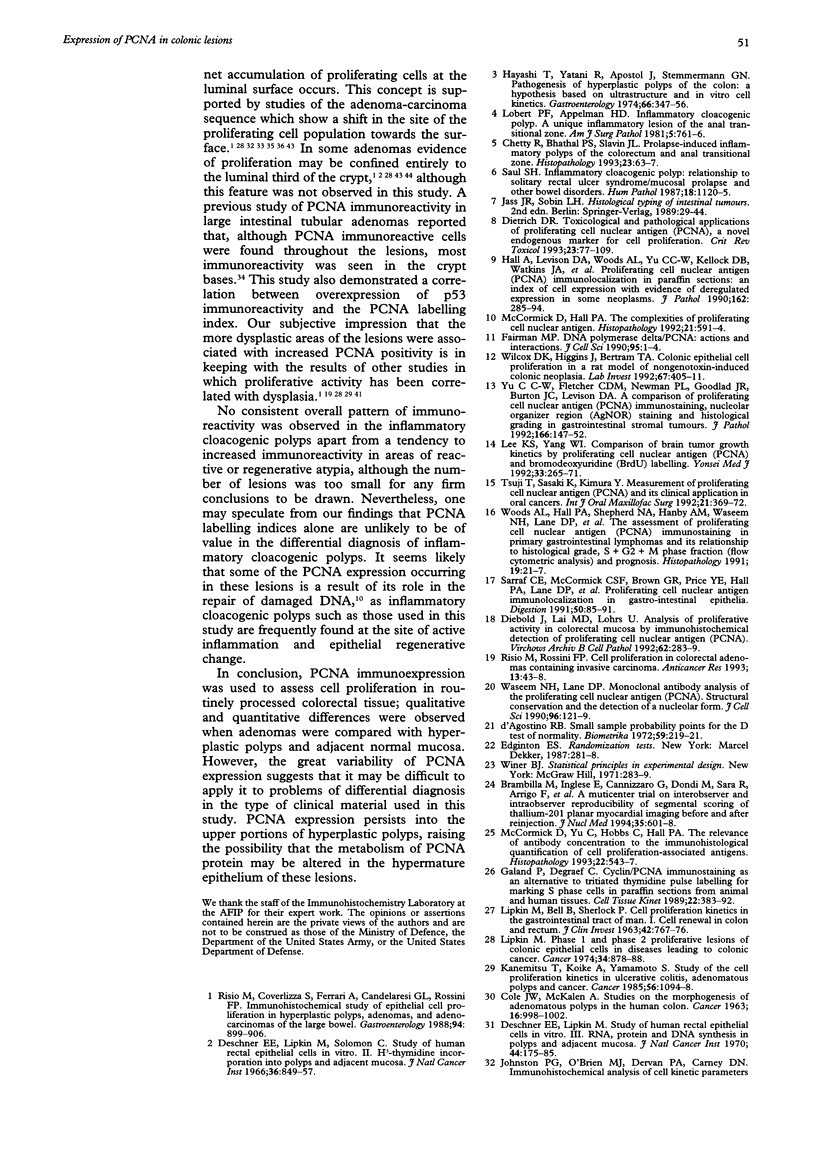
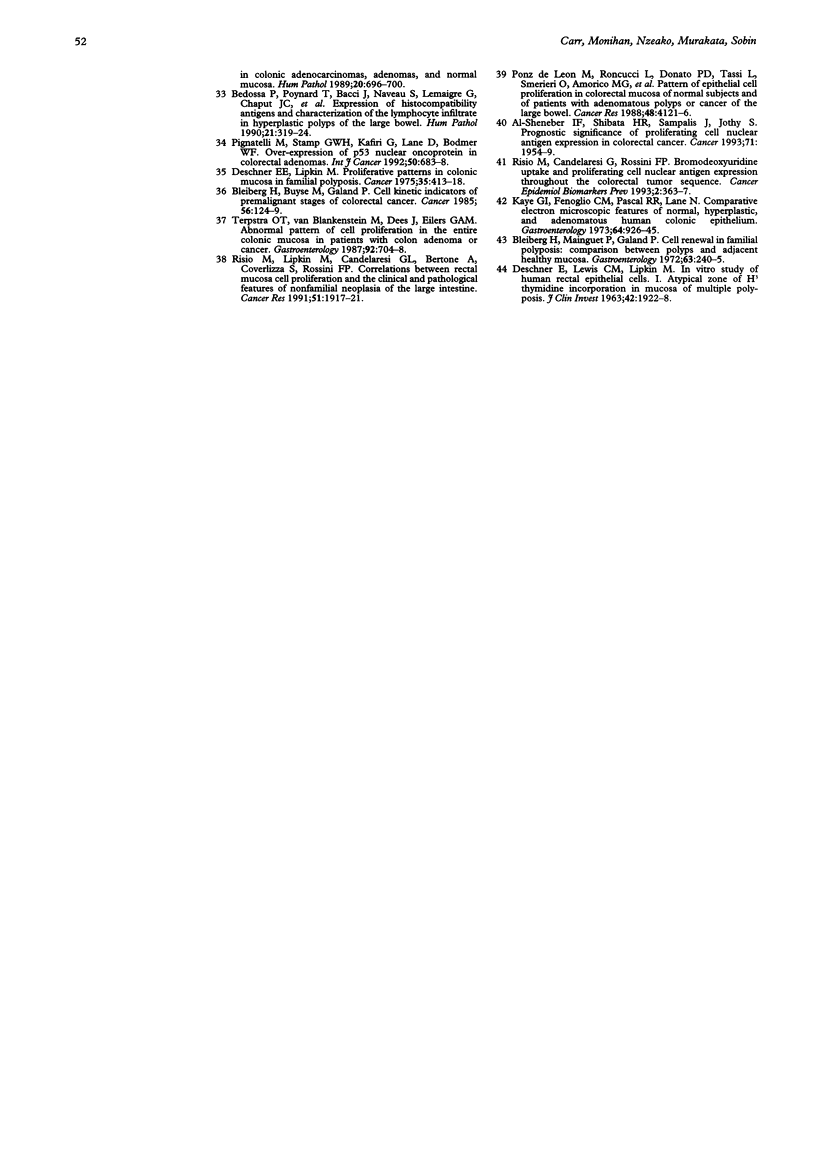
Images in this article
Selected References
These references are in PubMed. This may not be the complete list of references from this article.
- Bedossa P., Poynard T., Bacci J., Naveau S., Lemaigre G., Chaput J. C., Martin E. Expression of histocompatibility antigens and characterization of the lymphocyte infiltrate in hyperplastic polyps of the large bowel. Hum Pathol. 1990 Mar;21(3):319–324. doi: 10.1016/0046-8177(90)90233-u. [DOI] [PubMed] [Google Scholar]
- Bleiberg H., Buyse M., Galand P. Cell kinetic indicators of premalignant stages of colorectal cancer. Cancer. 1985 Jul 1;56(1):124–129. doi: 10.1002/1097-0142(19850701)56:1<124::aid-cncr2820560119>3.0.co;2-y. [DOI] [PubMed] [Google Scholar]
- Bleiberg H., Mainguet P., Galand P. Cell renewal in familial polyposis: comparison between polyps and adjacent healthy mucosa. Gastroenterology. 1972 Aug;63(2):240–245. [PubMed] [Google Scholar]
- Brambilla M., Inglese E., Cannizzaro G., Dondi M., Sara R., Arrigo F., Tarolo G. L. A multicenter trial on interobserver and intraobserver reproducibility of segmental scoring of thallium-201 planar myocardial imaging before and after reinjection. Italian Group of Nuclear Cardiology. J Nucl Med. 1994 Apr;35(4):601–608. [PubMed] [Google Scholar]
- COLE J. W., MCKALEN A. STUDIES ON THE MORPHOGENESIS OF ADENOMATOUS POLYPS IN THE HUMAN COLON. Cancer. 1963 Aug;16:998–1002. doi: 10.1002/1097-0142(196308)16:8<998::aid-cncr2820160806>3.0.co;2-c. [DOI] [PubMed] [Google Scholar]
- Chetty R., Bhathal P. S., Slavin J. L. Prolapse-induced inflammatory polyps of the colorectum and anal transitional zone. Histopathology. 1993 Jul;23(1):63–67. doi: 10.1111/j.1365-2559.1993.tb01184.x. [DOI] [PubMed] [Google Scholar]
- DESCHNER E., LEWIS C. M., LIPKIN M. IN VITRO STUDY OF HUMAN RECTAL EPITHELIAL CELLS. I. ATYPICAL ZONE OF H3 THYMIDINE INCORPORATION IN MUCOSA OF MULTIPLE POLYPOSIS. J Clin Invest. 1963 Dec;42:1922–1928. doi: 10.1172/JCI104878. [DOI] [PMC free article] [PubMed] [Google Scholar]
- Deschner E. E., Lipkin M. Proliferative patterns in colonic mucosa in familial polyposis. Cancer. 1975 Feb;35(2):413–418. doi: 10.1002/1097-0142(197502)35:2<413::aid-cncr2820350217>3.0.co;2-b. [DOI] [PubMed] [Google Scholar]
- Deschner E. E., Lipkin M. Study of human rectal epithelial cells in vitro. III. RNA, protein, and DNA synthesis in polyps and adjacent mucosa. J Natl Cancer Inst. 1970 Jan;44(1):175–185. [PubMed] [Google Scholar]
- Diebold J., Lai M. D., Löhrs U. Analysis of proliferative activity in colorectal mucosa by immunohistochemical detection of proliferating cell nuclear antigen (PCNA). Methodological aspects and application to routine diagnostic material. Virchows Arch B Cell Pathol Incl Mol Pathol. 1992;62(5):283–289. doi: 10.1007/BF02899694. [DOI] [PubMed] [Google Scholar]
- Dietrich D. R. Toxicological and pathological applications of proliferating cell nuclear antigen (PCNA), a novel endogenous marker for cell proliferation. Crit Rev Toxicol. 1993;23(1):77–109. doi: 10.3109/10408449309104075. [DOI] [PubMed] [Google Scholar]
- Fairman M. P. DNA polymerase delta/PCNA: actions and interactions. J Cell Sci. 1990 Jan;95(Pt 1):1–4. doi: 10.1242/jcs.95.3.1. [DOI] [PubMed] [Google Scholar]
- Galand P., Degraef C. Cyclin/PCNA immunostaining as an alternative to tritiated thymidine pulse labelling for marking S phase cells in paraffin sections from animal and human tissues. Cell Tissue Kinet. 1989 Sep;22(5):383–392. doi: 10.1111/j.1365-2184.1989.tb00223.x. [DOI] [PubMed] [Google Scholar]
- Hall P. A., Levison D. A., Woods A. L., Yu C. C., Kellock D. B., Watkins J. A., Barnes D. M., Gillett C. E., Camplejohn R., Dover R. Proliferating cell nuclear antigen (PCNA) immunolocalization in paraffin sections: an index of cell proliferation with evidence of deregulated expression in some neoplasms. J Pathol. 1990 Dec;162(4):285–294. doi: 10.1002/path.1711620403. [DOI] [PubMed] [Google Scholar]
- Hayashi T., Yatani R., Apostol J., Stemmermann G. N. Pathogenesis of hyperplastic polyps of the colon: a hypothesis based on ultrastructure and in vitro cell kinetics. Gastroenterology. 1974 Mar;66(3):347–356. [PubMed] [Google Scholar]
- Johnston P. G., O'Brien M. J., Dervan P. A., Carney D. N. Immunohistochemical analysis of cell kinetic parameters in colonic adenocarcinomas, adenomas, and normal mucosa. Hum Pathol. 1989 Jul;20(7):696–700. doi: 10.1016/0046-8177(89)90158-5. [DOI] [PubMed] [Google Scholar]
- Kanemitsu T., Koike A., Yamamoto S. Study of the cell proliferation kinetics in ulcerative colitis, adenomatous polyps, and cancer. Cancer. 1985 Sep 1;56(5):1094–1098. doi: 10.1002/1097-0142(19850901)56:5<1094::aid-cncr2820560523>3.0.co;2-8. [DOI] [PubMed] [Google Scholar]
- Kaye G. I., Fenoglio C. M., Pascal R. R., Lane N. Comparative electron microscopic features of normal, hyperplastic, and adenomatous human colonic epithelium. Variations in cellular structure relative to the process of epithelial differentiation. Gastroenterology. 1973 May;64(5):926–945. [PubMed] [Google Scholar]
- Lee K. S., Yang W. I. Comparison of brain tumor growth kinetics by proliferating cell nuclear antigen (PCNA) and bromodeoxyuridine (BrdU) labeling. Yonsei Med J. 1992 Sep;33(3):265–271. doi: 10.3349/ymj.1992.33.3.265. [DOI] [PubMed] [Google Scholar]
- Lipkin M., Bell B., Sherlock P. CELL PROLIFERATION KINETICS IN THE GASTROINTESTINAL TRACT OF MAN. I. CELL RENEWAL IN COLON AND RECTUM. J Clin Invest. 1963 Jun;42(6):767–776. doi: 10.1172/JCI104769. [DOI] [PMC free article] [PubMed] [Google Scholar]
- Lipkin M. Phase 1 and phase 2 proliferative lesions of colonic epithelial cells in diseases leading to colonic cancer. Cancer. 1974 Sep;34(3):suppl–suppl:888. doi: 10.1002/1097-0142(197409)34:3+<878::aid-cncr2820340715>3.0.co;2-r. [DOI] [PubMed] [Google Scholar]
- Lobert P. F., Appelman H. D. Inflammatory cloacogenic polyp. A unique inflammatory lesion of the anal transitional zone. Am J Surg Pathol. 1981 Dec;5(8):761–766. [PubMed] [Google Scholar]
- McCormick D., Hall P. A. The complexities of proliferating cell nuclear antigen. Histopathology. 1992 Dec;21(6):591–594. doi: 10.1111/j.1365-2559.1992.tb00454.x. [DOI] [PubMed] [Google Scholar]
- McCormick D., Yu C., Hobbs C., Hall P. A. The relevance of antibody concentration to the immunohistological quantification of cell proliferation-associated antigens. Histopathology. 1993 Jun;22(6):543–547. doi: 10.1111/j.1365-2559.1993.tb00174.x. [DOI] [PubMed] [Google Scholar]
- Pignatelli M., Stamp G. W., Kafiri G., Lane D., Bodmer W. F. Over-expression of p53 nuclear oncoprotein in colorectal adenomas. Int J Cancer. 1992 Mar 12;50(5):683–688. doi: 10.1002/ijc.2910500503. [DOI] [PubMed] [Google Scholar]
- Ponz de Leon M., Roncucci L., Di Donato P., Tassi L., Smerieri O., Amorico M. G., Malagoli G., De Maria D., Antonioli A., Chahin N. J. Pattern of epithelial cell proliferation in colorectal mucosa of normal subjects and of patients with adenomatous polyps or cancer of the large bowel. Cancer Res. 1988 Jul 15;48(14):4121–4126. [PubMed] [Google Scholar]
- Risio M., Candelaresi G., Rossini F. P. Bromodeoxyuridine uptake and proliferating cell nuclear antigen expression throughout the colorectal tumor sequence. Cancer Epidemiol Biomarkers Prev. 1993 Jul-Aug;2(4):363–367. [PubMed] [Google Scholar]
- Risio M., Coverlizza S., Ferrari A., Candelaresi G. L., Rossini F. P. Immunohistochemical study of epithelial cell proliferation in hyperplastic polyps, adenomas, and adenocarcinomas of the large bowel. Gastroenterology. 1988 Apr;94(4):899–906. doi: 10.1016/0016-5085(88)90545-8. [DOI] [PubMed] [Google Scholar]
- Risio M., Lipkin M., Candelaresi G., Bertone A., Coverlizza S., Rossini F. P. Correlations between rectal mucosa cell proliferation and the clinical and pathological features of nonfamilial neoplasia of the large intestine. Cancer Res. 1991 Apr 1;51(7):1917–1921. [PubMed] [Google Scholar]
- Risio M., Rossini F. P. Cell proliferation in colorectal adenomas containing invasive carcinoma. Anticancer Res. 1993 Jan-Feb;13(1):43–47. [PubMed] [Google Scholar]
- Sarraf C. E., McCormick C. S., Brown G. R., Price Y. E., Hall P. A., Lane D. P., Alison M. R. Proliferating cell nuclear antigen immunolocalization in gastro-intestinal epithelia. Digestion. 1991;50(2):85–91. doi: 10.1159/000200744. [DOI] [PubMed] [Google Scholar]
- Saul S. H. Inflammatory cloacogenic polyp: relationship to solitary rectal ulcer syndrome/mucosal prolapse and other bowel disorders. Hum Pathol. 1987 Nov;18(11):1120–1125. doi: 10.1016/s0046-8177(87)80379-9. [DOI] [PubMed] [Google Scholar]
- Terpstra O. T., van Blankenstein M., Dees J., Eilers G. A. Abnormal pattern of cell proliferation in the entire colonic mucosa of patients with colon adenoma or cancer. Gastroenterology. 1987 Mar;92(3):704–708. doi: 10.1016/0016-5085(87)90021-7. [DOI] [PubMed] [Google Scholar]
- Tsuji T., Sasaki K., Kimura Y., Yamada K., Mori M., Shinozaki F. Measurement of proliferating cell nuclear antigen (PCNA) and its clinical application in oral cancers. Int J Oral Maxillofac Surg. 1992 Dec;21(6):369–372. doi: 10.1016/s0901-5027(05)80765-9. [DOI] [PubMed] [Google Scholar]
- Waseem N. H., Lane D. P. Monoclonal antibody analysis of the proliferating cell nuclear antigen (PCNA). Structural conservation and the detection of a nucleolar form. J Cell Sci. 1990 May;96(Pt 1):121–129. doi: 10.1242/jcs.96.1.121. [DOI] [PubMed] [Google Scholar]
- Wilcox D. K., Higgins J., Bertram T. A. Colonic epithelial cell proliferation in a rat model of nongenotoxin-induced colonic neoplasia. Lab Invest. 1992 Sep;67(3):405–411. [PubMed] [Google Scholar]
- Woods A. L., Hall P. A., Shepherd N. A., Hanby A. M., Waseem N. H., Lane D. P., Levison D. A. The assessment of proliferating cell nuclear antigen (PCNA) immunostaining in primary gastrointestinal lymphomas and its relationship to histological grade, S+G2+M phase fraction (flow cytometric analysis) and prognosis. Histopathology. 1991 Jul;19(1):21–27. doi: 10.1111/j.1365-2559.1991.tb00890.x. [DOI] [PubMed] [Google Scholar]
- Yu C. C., Fletcher C. D., Newman P. L., Goodlad J. R., Burton J. C., Levison D. A. A comparison of proliferating cell nuclear antigen (PCNA) immunostaining, nucleolar organizer region (AgNOR) staining, and histological grading in gastrointestinal stromal tumours. J Pathol. 1992 Feb;166(2):147–152. doi: 10.1002/path.1711660210. [DOI] [PubMed] [Google Scholar]
- al-Sheneber I. F., Shibata H. R., Sampalis J., Jothy S. Prognostic significance of proliferating cell nuclear antigen expression in colorectal cancer. Cancer. 1993 Mar 15;71(6):1954–1959. doi: 10.1002/1097-0142(19930315)71:6<1954::aid-cncr2820710605>3.0.co;2-#. [DOI] [PubMed] [Google Scholar]



